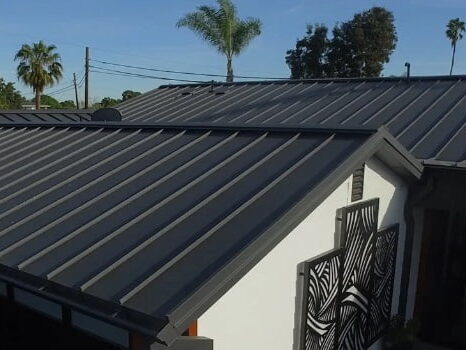On average, the lifecycle of a metal roof is around 40-60 years. This is one of the top advantages of a metal roof for your home.
Metal roofs have a higher upfront cost than other roofing materials, although most would agree their longevity is worth the initial investment. However, there are some issues that can compromise that longevity and possibly result in a roof replacement that’s sooner than expected.
At Alpha Commercial Roofing we want you to get full use of your metal roof so we’ve compiled a list of the main factors to be aware of that affect a metal roof’s longevity. By taking the proper precautions, you can increase the lifespan of your metal roof. A longer lifespan means you get more value out of your roof before you have to pay for a new one.
- Proper Installation of Metal Panels
- Choosing A Metal Roof That Is Right For Your Climate
- Choosing The Right Roofing For Your Roof Pitch
- Choosing The Right Metal Panel Gauge
- Keeping Up With Metal Roof Maintenance
1. Proper Installation Of Metal Panels
One of the most common reasons a metal roof has issues prematurely is due to errors made during the installation. Many times the mistakes are simple, such as not tightening screws properly or using the wrong sealant.
It is crucial to hire a roofing professional that has specialized experience with installing metal roof panels and has a valid contractor’s license. Depending on the type of panel used, metal roof installations require a different set of skills and tools than other types of roofing installations.
An installation that is done properly gives your roof the best chance of lasting as long as possible.
2. Choosing The Right Metal Roof For Your Climate
You don’t have any control over it, but weather can play a factor in the quality of your roof. Unfortunately, very harsh weather conditions like heavy snow and high winds can take a toll on any roof, not just metal.
If you live in an area with heavy snowfall, damage can potentially occur to the framing if the snow load builds up heavily and stays on the roof for an extended period of time.
While a snowstorm is out of your control, what you do after it isn’t and can help prolong the life of your roof. As long as it’s safe to do so, remove some of the snow to lighten the stress on the roof from the extra weight. Make sure that whatever tools you use to remove the snow, such as a snow rake, is safe to use on metal and will not cause scratches.
Metal is a strong material and this type of roofing can sustain winds up to 140 mph. Even so, if your area has hurricane force winds, you’ll want to do an inspection after the storm passes.
- Snowstorm: Check trim and flashing, as well as gutters. If you have snow guards make sure they are not damaged.
- High winds: Check for any damage from fallen branches, as well as loose or missing trim and flashing
- Hail storm: Check for loose fasteners, damage to trim and fashing as well as any denting.
You want to choose a metal roof panel that is right for your climate. In areas of heavy snow, you want a heavy gauge, mechanically seamed standing seam roof as they provide maximum weathertightness.
In areas with more mild weather conditions, you have more flexibility with the type of metal roof you choose.
3. Choosing The Right Roof Pitch
If a type of metal panel is used on a roof pitch that it is not recommended for, then the result could be repairs that need to be done from leaking.
The pitch of the roof refers to its steepness and states how many inches the slope rises for every 12 inches it runs horizontally. It can be expressed in degrees or as a percentage but is often seen in ratio form, such as 6:12. A 6:12 roof pitch means that the roof rises 6” for every 12” moving inward.
Certain types of metal roofing are not designed for roofs that are flat or have a very low pitch. A roof with a flatter pitch (below a .5/12) can accumulate water that leads to compromising the performance of the panel system.
A flat metal panel, such as standing seam, on a flat roof leaves nowhere for the water to drain. Eventually, the water will work its way underneath the roofing material resulting in rotting the substrate, color change, or leaks.
4. Choosing The Right Metal Panel Gauge
The metal gauge, or thickness, of a panel can affect its durability which then also affects its longevity.
Remember, as a metal gauge number gets lower, the metal gets thicker. A 24-gauge metal panel is thicker than a 29-gauge metal panel. In this case, a 24-gauge panel would be stronger than the thinner 29-gauge.
When it comes to harsh weather elements like snow, high winds or hail, a thinner material could be a problem.
If your house is located in a climate that has snowfall regularly, 29-gauge is not recommended. The weight of the snow could be too much for the roof to handle, resulting in leaks or even causing the roof to cave in.
Homeowners in areas that experience high winds also want to stay away from thinner metal. A 24-gauge roof is not only thicker but also heavier than 29-gauge. The added weight gives the roof a greater chance of staying intact in the event of a very heavy wind storm.
24 gauge will out-perform any 29 gauge material.
If you live in an area that experiences hail often, a thicker gauge is a better option to protect the lifespan of your metal roof.
5. Metal Roof Maintenance
Simple metal roof maintenance is the easiest way to catch an issue while it’s small, before it turns into a more serious situation. Not doing routine maintenance can cause problems that are forming to go undetected until after it’s too late, resulting in expensive repairs or even a roof replacement.
As mentioned earlier, inspections should be performed after extreme weather conditions. However, regular preventive roof maintenance should also be performed annually to stay ahead of any potential problems that can be forming.
Items To Check During A Preventive Metal Roof Inspection:
- Fasteners: Check for loose/ broken fasteners to avoid leaks.
- Foam Closures: Make sure they are in good condition and do not have any tears.
- Leaf Buildup: Make sure there is not a buildup of leaves or debris on the roof or in the gutters to avoid scratches on the surface or clogging in the gutters. Check these areas every 2-4 weeks depending on the leaf load in your area.
- Sealant: Make sure the sealant is not cracked, especially near chimneys, skylights, and valleys. Sealant is the number one reason a roof leaks as it has a short life span and usually isn’t replaced on time. The life expectancy of sealant should be listed on the container and replaced as suggested by the manufacturer.





